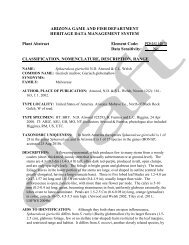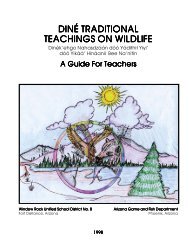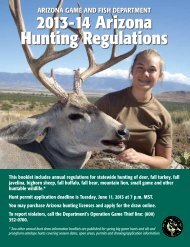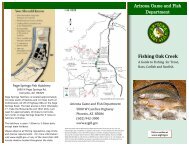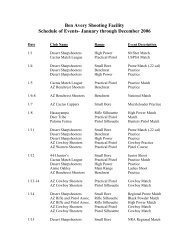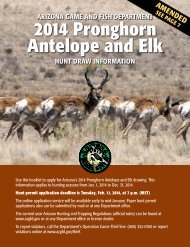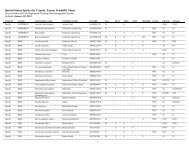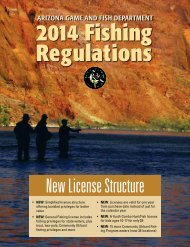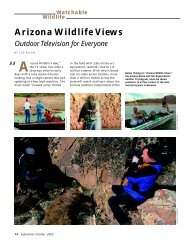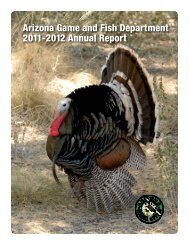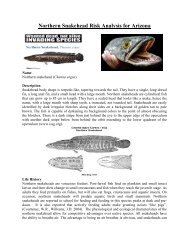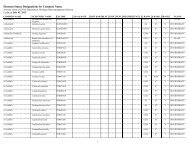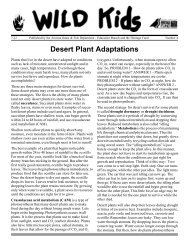Arizona toad, Bufo microscaphus
Arizona toad, Bufo microscaphus
Arizona toad, Bufo microscaphus
Create successful ePaper yourself
Turn your PDF publications into a flip-book with our unique Google optimized e-Paper software.
ARIZONA GAME AND FISH DEPARTMENT<br />
HERITAGE DATA MANAGEMENT SYSTEM<br />
Animal Abstract Element Code: AAABB01112<br />
Data Sensitivity: No<br />
CLASSIFICATION, NOMENCLATURE, DESCRIPTION, RANGE<br />
NAME:<br />
<strong>Bufo</strong> <strong>microscaphus</strong> <strong>microscaphus</strong><br />
COMMON NAME: <strong>Arizona</strong> Toad<br />
SYNONYMS:<br />
FAMILY: Anura: <strong>Bufo</strong>nidae<br />
AUTHOR, PLACE OF PUBLICATION: Cope. 1867. Proc. Acad. Nat. Sci. Phila. [1866]<br />
(18):300-314.<br />
TYPE LOCALITY: “Territory of <strong>Arizona</strong>, Upper Colorado River” Mohave County, <strong>Arizona</strong>.<br />
TYPE SPECIMEN: USNM 4106 and 4184<br />
TAXONOMIC UNIQUENESS: Seventeen bufonids in the United States, divided into<br />
several species-groups. B. <strong>microscaphus</strong> placed within B. americanus species-group. Of the<br />
six species within the B. americanus group, two are in the southwest, B. <strong>microscaphus</strong> and B.<br />
woodhousei. Two subspecies of B. <strong>microscaphus</strong> exist in the United States: B.m.<br />
<strong>microscaphus</strong> and B.m. californicus and one in Mexico, B.m. mexicanus.<br />
DESCRIPTION: (For B. <strong>microscaphus</strong>) - rather stocky <strong>toad</strong> 5.08-8.25 mm (2.0-3.25 in.)<br />
long, uniformly warty with a light-colored stripe across the head and eyelids. Oval-shaped<br />
widely separated parotoid glands, pale toward front. Dorsum varies in color from greenish<br />
gray, buff, brown, or salmon, with the color blending with the surrounding soil and rocks.<br />
Usually having a light area in the middle of the back and on each sacral hump. Buff coloring<br />
below, often lacking spots. Cranial crests absent or very weak (Stebbins 1985).<br />
AIDS TO IDENTIFICATION: B.m. <strong>microscaphus</strong> usually has little or no dorsal dark<br />
spotting. The skin tends to be relatively smooth. Parotoids elongate and nearly parallel. Male<br />
throat not dark.<br />
ILLUSTRATIONS: B&W drawing (Stebbins 1985: plate 12)<br />
Color photo (Behler and King 1979: plates 223 & 235)<br />
Color photo (Wildherps web site)<br />
Color photo (Livingunderworld web site)<br />
TOTAL RANGE: South central Utah at <strong>Arizona</strong> border (Sullivan 1991), southwestern Utah<br />
and southern Nevada southward into Mexican highlands of Durango and Chihuahua (Webb<br />
1972).
AGFD Animal Abstract -2- <strong>Bufo</strong> <strong>microscaphus</strong> <strong>microscaphus</strong><br />
RANGE WITHIN ARIZONA: East to west central <strong>Arizona</strong>, canyons and flood plains<br />
south of the Mogollon Rim, but also found in East Clear Creek (see Sullivan 1993, fig. 1 for<br />
map). Occurs in Apache, Coconino, Gila, Graham, Greenlee, La Paz, Maricopa, Mohave,<br />
Navajo, and Yavapai counties.<br />
SPECIES BIOLOGY AND POPULATION TRENDS<br />
BIOLOGY: Adults nocturnal except during the breeding season. Paratoid glands<br />
secrete a viscous white poison that when in contact with the mouth of a predator causes<br />
inflaming of the throat and causes nausea, irregular heart beat, and in extreme cases, death.<br />
Vocal is a pleasing musical trill raising in pitch at first and then ending abruptly after 10<br />
seconds.<br />
REPRODUCTION: Breeds February-July (earlier at lower elevations) but may be abroad until<br />
September. Breeding not dependant on rainfall as with many other species. Egg strands are<br />
laid on bottom of pools.<br />
FOOD HABITS:<br />
Arthropods, some snails.<br />
HABITAT: Rocky streams and canyons in the pine-oak belt. Also occurs in lower<br />
deserts e.g. Agua Fria River area. (See Sullivan 1993 for map, Fig. 1).<br />
ELEVATION: Near sea level to around 8,000 feet (2,440 m). Based on records from the<br />
Heritage Data Management System, elevation ranges from 480-8400 ft (146-2560 m) (AGFD,<br />
unpublished data accessed 2002).<br />
PLANT COMMUNITY:<br />
Upland desert and evergreen woodland.<br />
POPULATION TRENDS: Hybridization with Woodhouse <strong>toad</strong> has been thought to be a<br />
threat in dammed aquatic systems. Apparently stable at other localities, but no good<br />
documentation anywhere.<br />
SPECIES PROTECTION AND CONSERVATION<br />
ENDANGERED SPECIES ACT STATUS: None (USDI, FWS 1996)<br />
[C2 USDI, FWS 1994]<br />
[C2 USDI, FWS 1991]<br />
[C2 USDI, FWS 1989]<br />
STATE STATUS:<br />
OTHER STATUS:<br />
None<br />
Forest Service Sensitive (USDA, FS Region<br />
3 1999)
AGFD Animal Abstract -3- <strong>Bufo</strong> <strong>microscaphus</strong> <strong>microscaphus</strong><br />
MANAGEMENT FACTORS: Water diversions and manipulations (e.g. dams), heavy<br />
grazing in riparian areas.<br />
PROTECTIVE MEASURES TAKEN:<br />
amphibians.<br />
<strong>Arizona</strong> fishing license required to take open season<br />
SUGGESTED PROJECTS: Periodic surveys at historical localities.<br />
LAND MANAGEMENT/OWNERSHIP: BIA – Fort Apache, Hualapai, San Carlos, and<br />
Yavapai-Apache Reservations; BLM – <strong>Arizona</strong> Strip, Kingman, Phoenix, and Safford Field<br />
Offices; FWS – Havasu and Bill Williams National Wildlife Refuges; USFS – Apache-<br />
Sitgreaves, Coconino, Prescott, and Tonto National Forests; State Land Department; AGFD -<br />
Alamo Wildlife Area and Page Springs Fish Hatchery; Alamo Lake State Park; Lake Pleasant<br />
County Park; TNC – Hassayampa River Preserve; Private.<br />
SOURCES OF FURTHER INFORMATION<br />
REFERENCES:<br />
Behler, J.L. and F.W. King. 1979. The Audubon Society field guide to North American<br />
reptiles and amphibians. Alfred A. Knopf, New York. P.394.<br />
BISON-M, Biota Information System of New Mexico, web site.<br />
http://nmnhp.unm.edu/bisonm/bisonquery.php.<br />
eNature web site. http://www.enature.com<br />
Livingunderworld web site. In<br />
http://livingunderworl.org/gallery/photos/anura/bufonidae/bufo/<strong>microscaphus</strong>/links/001.htm<br />
Lowe, C.H. 1964. Amphibians and reptiles. The vertebrates of <strong>Arizona</strong>. University of <strong>Arizona</strong><br />
Press, Tucson. p.156.<br />
Painter, C.W. 1994. Letter to J. Fowler-Propst (USFWS) re update of 1991 Animal Notice of<br />
Review. New Mexico Game and Fish , Santa Fe.<br />
Smith, H.M. 1978. Amphibians of North America. Golden Press, New York. Pp. 40-41.<br />
Stebbins, R.C. 1951. Amphibians of western North America. University of California Press,<br />
Berkeley. Pp. 266-280.<br />
Stebbins, R.C. 1985. A field guide to reptiles and amphibians. Second edition, revised.<br />
Houghton Mifflin Company, Boston. Pp. 72-73.<br />
Sullivan, B.K. 1986. Hybridization between the <strong>toad</strong>s <strong>Bufo</strong> <strong>microscaphus</strong> and <strong>Bufo</strong><br />
woodhousei in <strong>Arizona</strong>: morphological variation. Journal of Herpetology 20(1): 11-21.<br />
Sullivan, B.K. 1989. Desert environments and the structure of anuran mating systems. Journal<br />
of Arid Environments 17: 175-183.<br />
Sullivan, B.K. 1991. Distribution and status of the <strong>Arizona</strong> Toad, <strong>Bufo</strong> <strong>microscaphus</strong><br />
<strong>microscaphus</strong>. Unpublished report for Nongame Branch of the <strong>Arizona</strong> Game and Fish<br />
Department.<br />
Sullivan, B.K. 1993. Distribution of the southwestern <strong>toad</strong> (<strong>Bufo</strong> <strong>microscaphus</strong>) in <strong>Arizona</strong>.<br />
Great Basin Naturalist 53: 402-406.
AGFD Animal Abstract -4- <strong>Bufo</strong> <strong>microscaphus</strong> <strong>microscaphus</strong><br />
Sullivan, B.K. and T. Lamb. 1988. Hybridization between the <strong>toad</strong>s <strong>Bufo</strong> <strong>microscaphus</strong> and<br />
<strong>Bufo</strong> woodhousei in <strong>Arizona</strong>: variation in release calls and allozymes. Herpetologica<br />
44(3): 325-333.<br />
USDA, Forest Service Region 3. 1999. Regional Forester’s Sensitive Species List.<br />
USDI, Fish and Wildlife Service. 1989. Endangered and Threatened Wildlife and Plants;<br />
Animal Notice of Review. Federal Register 54(4): 558.<br />
USDI, Fish and Wildlife Service. 1991. Endangered and Threatened Wildlife and Plants;<br />
Animal Candidate Review for Listing as Endangered or Threatened Species; Proposed<br />
Rule. Federal Register 56(225): 58813.<br />
USDI, Fish and Wildlife Service. 1994. Endangered and Threatened Wildlife and Plants;<br />
Animal Candidate Review for Listing as Endangered or Threatened Species; Proposed<br />
Rule. Federal Register 59(219): 58995.<br />
USDI, Fish and Wildlife Service. 1996. Endangered and Threatened Wildlife and Plants:<br />
Review of Plant and Animal Taxa that are Candidates for Listing as Endangered or<br />
Threatened Species. Federal Register 61(40): 7596-7613.<br />
Vitt, L.J. and R.D. Ohmart. 1978. Herpetofauna of the Lower Colorado River. Western<br />
Foundation Vertebrate Zoo. Los Angeles, California. II(2): 43.<br />
Webb, R.G. 1972. Resurrection of <strong>Bufo</strong> mexicanus brocchi for a highland <strong>toad</strong> in western<br />
Mexico. Herpetologica 28: 1-6.<br />
Wildherps Web site. http://www.wildherps.com/species/B.mircoscaphus.html.<br />
MAJOR KNOWLEDGEABLE INDIVIDUALS:<br />
Brian Sullivan - <strong>Arizona</strong> State University (West), Phoenix, <strong>Arizona</strong>.<br />
ADDITIONAL INFORMATION:<br />
Hybridizes with <strong>Bufo</strong> woodhousei along Virgin River and in central <strong>Arizona</strong>.<br />
Revised: 1992-12-17 (SSS)<br />
1995-03-28 (MJS)<br />
1997-03-03 (SMS)<br />
2002-11-20 (RHB)<br />
To the user of this abstract: you may use the entire abstract or any part of it. We do request,<br />
however, that if you make use of this abstract in plans, reports, publications, etc. that you credit<br />
the <strong>Arizona</strong> Game and Fish Department. Please use the following citation:<br />
<strong>Arizona</strong> Game and Fish Department. 20XX (= year of last revision as indicated at end of<br />
abstract). X...X (= taxon of animal or plant). Unpublished abstract compiled and<br />
edited by the Heritage Data Management System, <strong>Arizona</strong> Game and Fish Department,<br />
Phoenix, AZ. X pp.



